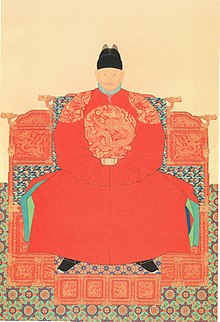Yi Seonggye
| Yi Seong-gye Yi Dan |
|||||||||
|---|---|---|---|---|---|---|---|---|---|

Portrait of King Taejo of Joseon
|
|||||||||
| King of Joseon | |||||||||
| Reign | 5 August 1392 – 14 October 1398 | ||||||||
| Coronation | 5 August 1392 | ||||||||
| Predecessor |
Dynasty established Gongyang of Goryeo as King of Goryeo |
||||||||
| Successor | Jeongjong of Joseon | ||||||||
| Former King of Joseon | |||||||||
| Tenure | 14 October 1398 – 28 November 1400 | ||||||||
| Successor | Jeongjong of Joseon | ||||||||
| Grand Former King of Joseon | |||||||||
| Tenure | 28 November 1400 – 18 June 1408 | ||||||||
| Successor | Jeongjong of Joseon | ||||||||
| Born |
October 27, 1335 Hamheung, Hamgyeong Province, Kingdom of Goryeo |
||||||||
| Died | June 18, 1408 (aged 72) Changdeok Palace, Kingdom of Joseon |
||||||||
| Burial | Geonwolleung, Part of the Donggureung Tomb Cluster. | ||||||||
| Consort |
Queen Shinui Queen Shindeok |
||||||||
| Issue |
Jeongjong of Joseon Taejong of Joseon |
||||||||
|
|||||||||
| House | Jeonju Yi | ||||||||
| Father | Hwanjo of Joseon | ||||||||
| Mother | Queen Uihye | ||||||||
| Religion | Buddhism | ||||||||
| Posthumous name | |
|---|---|
| King Taejo Kangheon Jiin Gyewun Seongmun Shinmu the Great of Joseon 태조강헌지인계운성문신무대왕 太祖康獻至仁啓運聖文神武大王 |
|
| Temple name | |
| Taejo |
| Korean name | |
| Hangul | 태조 |
|---|---|
| Hanja | 太祖 |
| Revised Romanization | Taejo |
| McCune–Reischauer | T'aejo |
| Pen name | |
| Hangul | 송헌 |
| Hanja | 松軒 |
| Revised Romanization | Songheon |
| McCune–Reischauer | Songhŏn |
| Birth name | |
| Hangul | 이성계 later 이단 |
| Hanja | 李成桂 later 李旦 |
| Revised Romanization | I Seonggye later I Dan |
| McCune–Reischauer | Yi Sŏngkye later Yi Tan |
| Courtesy name | |
| Hangul | 중결 |
| Hanja | 仲潔 |
| Revised Romanization | Junggyeol |
| McCune–Reischauer | Chunggŏl |
Taejo of Joseon (27 October 1335 – 18 June 1408), born Yi Seong-gye, whose changed name is Yi Dan, was the founder and the first king of the Joseon Dynasty of Korea reigning from 1392 to 1398, and the main figure in overthrowing the Goryeo Dynasty. He was posthumously raised to the rank of Emperor in 1899 by Gojong, the Gwangmu Emperor, who had proclaimed the Korean Empire in 1897. The Korean Empire would last merely 11 years until the entire dynastic system ended with the Japanese annexation in 1910.
Taejo's father Yi Ja-chun was a minor Mongol official, but his ethnicity was Korean. Taejo joined the Goryeo army and rose through the ranks, seizing the throne in 1392. He abdicated in 1398 during the strife between his sons and died in 1408.
By the late 14th century, the 400-year-old Goryeo Dynasty established by Wang Geon in 918 was tottering, its foundations collapsing from years of war and de facto occupation by the disintegrating Mongol Empire. The legitimacy of Korea itself was also becoming an increasingly disputed issue within the court, as the ruling house failed not only to govern the kingdom effectively, but was also tarnished by generations of forced intermarriage with members of the Mongol Yuan Dynasty imperial family and by rivalry amongst the various Goryeo Dynasty royal family branches (even King U's mother was a known commoner, thus leading to rumors disputing his descent from King Gongmin).
Within the kingdom, influential aristocrats, generals, and even prime ministers struggled for royal favor and vied for domination of the court, resulting in deep divisions among various factions. With the ever-increasing number of raids against Goryeo conducted by Japanese pirates (wakō) and the Red Turbans invasions of Korea, those who came to dominate the royal court were the reformed-minded Sinjin aristocracy and the opposing Gweonmun aristocracy, as well as generals who could actually fight off the foreign threats—namely a talented general named Yi Seong-gye and his rival Choe Yeong. With the rise of the Ming Dynasty under a former monk, Zhu Yuanzhang (the Hongwu Emperor), Mongol forces became more vulnerable. By the 1350s Goryeo regained its full independence from the waning Mongol Empire, although Mongol remnants effectively occupied northeastern territories with large garrisons of troops.
...
Wikipedia
